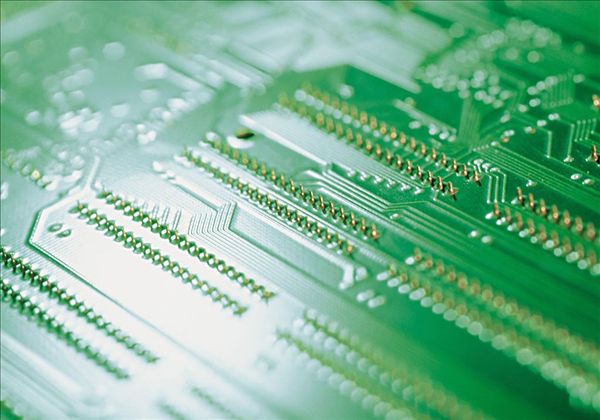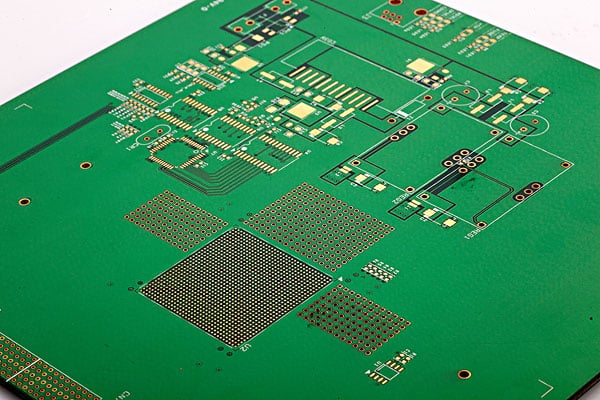What problems should be paid attention to in the PCB circuit board stack-up design? Below is the advice given by our professional engineers with extensive PCB design experience.
When designing a stack up, be sure to follow two rules:
- Each trace layer must have an adjacent reference layer (power or ground);
- The adjacent main power plane and the ground plane should maintain a minimum distance to provide larger coupling capacitance.
Let’s take an example of two, four, and six-layer PCB boards to illustrate:
Lamination of single-sided and double-sided PCBs
For a double-layer CB board, controlling EMI radiation is mainly considered from the routing and layout.
The electromagnetic compatibility problem of single-layer PCB boards and double-layer PCB boards is becoming more and more prominent. The main reason for this phenomenon is that the signal loop area is too large, which produces intense electromagnetic radiation and makes the circuit sensitive to external interference. To improve the electromagnetic compatibility of the line, the easiest way is to reduce the loop area of the key signal; the key signal mainly refers to the signal that produces intense radiation and the signal that is sensitive to the outside world.

Single and double layer circuit boards are usually used in low-frequency analog designs below 10KHz
1) The power circuit on the same layer are routed radially, and the sum of the lengths of the circuit is minimized;
2) When laying out the power supply and ground circuit, they should be close to each other; lay a ground routing on the side of the critical signal, and this ground routing should be as close to the signal routing as possible. In this way, a smaller loop area is formed, and the sensitivity of differential mode radiation to external interference is reduced.
3) If it is a double-layer circuit board, you can lay a ground routing along with the signal routing on the other side of the circuit board, close to the bottom of the signal routing, and the circuit should be as wide as possible.
Lamination of four-layer PCB boards
- SIG-GND(PWR)-PWR (GND)-SIG,
- GND-SIG(PWR)-SIG(PWR)-GND,
The potential problem for the above two stack-up designs is for the traditional 1.6mm (62mil) board thickness. The layer spacing will become very large, which is not conducive to controlling impedance, interlayer coupling, and shielding; significantly, the large spacing between the power supply layer and the ground layer reduces the board capacitance and is not conducive to filtering noise.
The first solution is usually used when there are many chips on the PCB board. This scheme can get better SI performance, but not very good for EMI performance, mainly controlled by traces and other details.
The second solution is usually used when the chip density on the PCB is low enough, and there is enough space around the chip. In this scheme, the outer layers of the PCB are ground layers, and the two middle layers are signal/power layers. This is the best 4-layer PCB structure available from an EMI control perspective.
Note: The distance between the middle two signal and power mixed layers should be widened. The wiring direction should be vertical to avoid crosstalk; the board area should be adequately controlled to reflect the 20H rule.

Lamination of six-layer PCB board
For the design with high chip density and high clock frequency, the design of a 6-layer PCB board should be considered. The recommended stacking method is as follows:
- SIG-GND-SIG-PWR-GND-SIG;
This stack-up scheme results in better signal integrity. The signal layer is adjacent to the ground layer, the power layer and the ground layer are paired, the impedance of each trace layer can be well controlled, and both ground layers can absorb magnetic lines of force well.
- GND-SIG-GND-PWR-SIG-GND;
This solution is only suitable for the case where the density of components is not very high. This kind of stack has all the advantages of the above stack, and the ground planes of the top and bottom layers are relatively complete, which can be used as a better shielding layer. Therefore, the EMI performance is better than the first solution.
Summary: Comparing the first scheme with the second scheme, the cost of the second scheme is significantly increased. Therefore, we usually choose the first solution when stacking.
Recommended Posts
Navigating the PCB Manufacturing Process Part 1: Unveiling MI, Cutting, and Drilling
Dive into the world of PCB manufacturing with our comprehensive guide, focusing on three crucial stages: Manufacturing Instruction (MI), Material Cutting, and Drilling. Join us on a journey through precision and innovation at JHYPCB, where every step in the process plays a vital role in creating high-quality printed circuit boards.
What is the Difference Between PTH and Via in PCBs?
Understanding the key differences between PTH and via is essential for optimizing PCB design and manufacturing. This article defines PTH and via, compares dimensions, functions, locations and finishing requirements. Typical applications and design considerations are also discussed.
Big news! DuPont announces the acquisition of Rogers.
DuPont Announces The Acquisition Of Rogers.
How to Choose a Reliable PCB Manufacturer in Europe
Choosing a reliable PCB manufacturer in Europe requires evaluating key factors like location, manufacturing expertise, quality certifications, turnaround times and customer service. This guide covers tips for assessing potential suppliers’ capabilities, prioritizing standards like ISO and IPC, reviewing logistics and support, and identifying the best European PCB partner for your needs. It also highlights considering global manufacturers like JHYPCB for advanced offerings combined with competitive pricing.
How to Select the Right Flexible PCB Manufacturer for Your Product: A 6-Step Guide
Flexible PCBs are gaining adoption across industries for their unique capabilities. However, identifying the right manufacturing partner is imperative to harness the benefits. This article provides a step-by-step guide to evaluating and selecting an optimal flexible PCB maker based on their competencies, quality control, materials, pricing, capacity and more.
By approaching flex PCB partner selection systematically, you can find the ideal match for your specific product needs. Learn what to look for and how to make the right choice when embarking on a new flex PCB project. Take the guesswork out of this crucial decision.
Custom PCB Assembly Services for Low-Volume & Specialty Needs
Custom PCB assembly services offer tailored solutions for low-volume, prototype, and specialized electronic manufacturing needs. From quick turnarounds for prototyping to integrating non-standard components and processes, these providers cater to businesses, hobbyists, and academics alike. Discover the benefits of customized PCB assembly for your next project.











